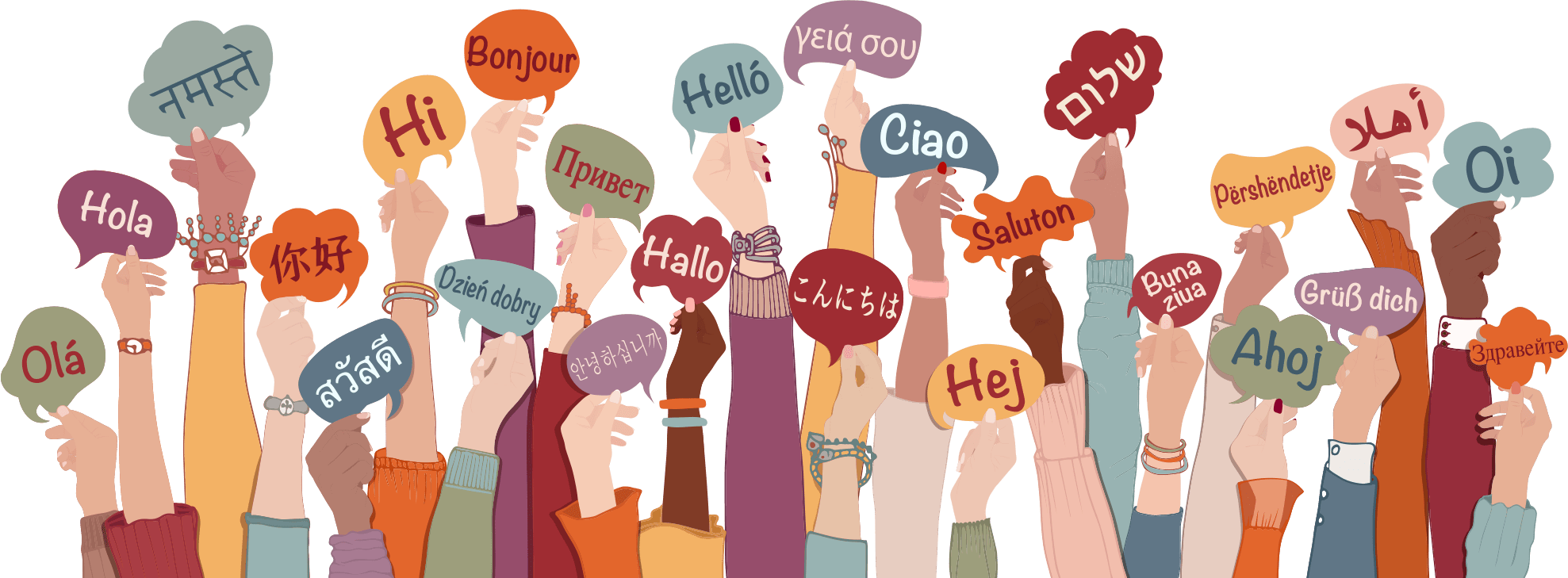newcomer
students

anguage wasn’t Tanya Kravchuk’s primary challenge as a newcomer student starting her educational journey in the United States — rather, it was the cultural differences that regularly created uncomfortable situations with teachers and peers.


t times, that meant saving up all of the candy she got from August through October to bring to school the day after Halloween to pretend that her family had gone trick or treating. Or, in one instance, turning in her cousin’s art project as her own because her mom didn’t want to spend the family’s limited, hard-earned money on supplies. “My teacher was so upset that I ‘lied’ and told me to call my mom and admit what I did,” Kravchuk recalled “I almost laughed aloud because my mom was the one who told me to use my cousin’s project.”
Newcomer students — immigrant students in their first years at U.S. schools — often require specialized curricula and instruction to succeed academically, as well as access to numerous social services to meet housing, food, legal aid and mental health needs. They also represent a growing student population, particularly in California, where about one in 40 students in the state was a newcomer in the 2021–22 school year, according to a report released in May by Policy Analysis for California Education (PACE).
A broad term for students in their first months or years of schooling in the U.S., “newcomer” doesn’t have a singular definition. Newcomer youth may be refugees and asylees who fled their country of origin because of persecution, war or violence, or students with interrupted formal education who are behind multiple grade levels in academic content because of limited schooling in their country of origin, or even unaccompanied minors or undocumented students, said Jorge Cuevas Antillon, San Diego County Office of Education’s district advisor of Multilingual Education and Global Achievement.
A whole child approach is necessary to support these children, said Kravchuk. “If we want newcomers to not only adapt but actually thrive in school, we must take into account all of their needs as they adjust to a new culture, language, home, neighborhood, rules, customs, laws and so much more. Those aspects of the person are not separate from the student in our classroom — they are a part of the student in our classroom and if we hope to engage the mind, then we must address the whole child. It emphasizes the interconnectedness of these developmental areas, underscoring that each one must be nurtured to ensure a child’s overall well-being and success,” she said.
U.S. Department of Education webinar
Lessons from the Field– Supporting Newcomer Students
csba.pub/newcomerwebinar
“Desert Sands serves a diverse group of newcomer students from various countries,” said Nancy Velador, the district’s multilingual coordinator. “Data indicates that there has been a steady increase in newcomer enrollment in recent years, with the highest numbers coming from countries experiencing economic challenges and political instability. Serving newcomer youth does come with specific challenges [that] can differ depending on the child’s age range. For younger students, language acquisition is a primary concern. Older students might face challenges related to credit transfer and graduation requirements, as well as acculturation.”
In Desert Sands, Velador says the district provides translation services and workshops for parents to bridge the gap. “Collaboration is key,” she said, noting that when they can begin to truly acclimate, “newcomer students bring invaluable diversity to our school climate. They offer different perspectives, cultures and experiences, enriching the learning environment for all students. This exposure promotes tolerance, empathy and cultural understanding.”
With supports in place, students facing challenges overlapping with newcomer students can thrive. For instance, the district’s new Migrant Leadership Club saw four of its 10 participating students — those who graduated in 2023 — accepted into colleges including California State Polytechnic University, Pomona, and Stanford University. “The Migrant Leadership Club provides a platform for students to develop leadership skills, support one another and give back to their community,” Velador said.

“To address students’ broader needs, San Diego COE continues to support schools and communities via the Student Services and Programs division with socioemotional and other health services, as well as partner with organizations that service such students, such as those for refugee and immigrant newcomer families,” Antillon said.
The county, which touches the U.S.-Mexico border, serves a significant number of unaccompanied minors and transborder students — those who cross the border to attend school. In an extraordinary effort to support these students during the pandemic, San Diego COE opened a large, temporary school called Futuro Brillante to provide educational services for more than 3,000 unaccompanied, undocumented minors who had arrived in the U.S. when government agencies were severely backlogged.
“While students were being processed by immigration officers, San Diego COE pooled its resources and gathered its staff of educators to teach classes Monday through Friday using the safest means possible during the COVID crisis. Many of the students who arrived were English learners, and thus, teaching language, literacy and the United States context were some of the priorities,” Antillon recalled. “Students who are English learners have a high likelihood of having greater needs than language. Human development is a critical responsibility of schooling and SDCOE takes its role to support positive socioemotional development seriously because students learn best when their basic needs are addressed.”
One of the six PACE reports on newcomer students describes in great detail how Futuro Brillante welcomed students, addressed their needs and prepared them for the next stage of seeking asylum in the U.S., and the partnerships, resources and more it took to make the school a success.
If we want newcomers to not only adapt but actually thrive in school, we must take into account all of their needs as they adjust to a new culture, language, home, neighborhood, rules, customs, laws and so much more.”

Language barriers often present challenges on two fronts: academically and socially. A large population of newcomer students are not literate in their home language, making it more difficult to address barriers, especially at the high school level where teachers are not trained in teaching aspects of reading often targeted to younger children, Kravchuk said. The language barrier also “makes it difficult to socialize and connect to peers. Social connection is a huge part of public education and when students don’t feel connected, they check out, [which] often leads to behavior problems,” she continued.
Kravchuk can empathize with these students, noting that in the early ‘90s, schools emphasized English language acquisition — inclusion and diversity were, at most, an afterthought.
“We experienced a lot of bullying and I was constantly afraid for my safety,” she said. “My parents were working multiple jobs and trying to navigate multiple challenges and survive in our new country. I knew that I couldn’t share any of that with them and add additional worry to their plate. It would have been nice to have a mentor or adult to talk to about all my fears and create some strategies for success.”
To address these challenges effectively now, San Juan USD implements a combination of specialized support programs, English language development (ELD) instruction, counseling services and community partnerships — many of which are highlighted in one of PACE’s reports on newcomer youth. Additionally, recognizing and respecting the unique needs of students of different ages is essential to providing tailored support and fostering a positive educational experience for newcomers, Kravchuk said.
She noted that the district’s bilingual instructional assistants and refugee community liaisons who serve as a bridge between the ethnic communities and the schools “have been instrumental in facilitating trust and disseminating information in a way that families understand.” One liaison even created community libraries at various apartment complexes with information about local resources and school events in the dominant languages of the residents.
“I really love that San Juan USD has a Saturday Academy for newcomers, offering [them] an intensive English language acquisition experience focused on English, art and physical education,” Kravchuk said. The academy consists of 150 minutes of ELD instruction, 30 minutes of art, 30 minutes of social-emotional support/self-esteem building and 30 minutes of fitness, all with an emphasis on oral language for six consecutive Saturdays. There is also a parent component with workshops on topics including graduation requirements, using the district parent portal, employment pathways, adult education, counseling support and public library services.
Newcomer students bring invaluable diversity to our school climate. They offer different perspectives, cultures, and experiences, enriching the learning environment for all students.”
That is a great first step, but what do districts still need? “Isn’t the answer always money?” Kravchuk asked. “We have certain things in place, but I’d love to see more support.” She said financial assistance or grants for schools serving a significant population of newcomer students to cover the costs associated with their unique needs would be helpful, as would additional staff to shadow students and provide an individualized strategic plan that is collaboratively created with a newcomer and their family that includes the student’s goals and a realistic timeline to help them navigate challenges. Another need is ensuring equitable access to technology and the internet for students.
Desert Sands USD’s Velador said funding for specialized English language programs, additional counselors and support staff, and resources for addressing trauma would be helpful, as many newcomer students have faced adverse experiences in their home countries. “Each child we help integrate into the education system has the potential to thrive and contribute to society,” she said.
Embracing newcomer students is critical to community-building, Kravchuk agreed. The challenges and adversity faced by these children has helped them develop resilience and problem-solving abilities that can inspire American students to be more adaptable and resourceful in overcoming obstacles, and make them more empathetic and compassionate, she said.
“In a world where we are often divided, it’s great for students to learn about how our differences can make us stronger. Kids are super resilient, and adversity does make people stronger,” Kravchuk continued. “However, many people don’t realize that resilience in students is fostered through nurturing, supportive relationships and the cultivation of essential coping skills for challenging situations. The solution lies in the relationship. Implement mentorship programs, support teams or extracurricular activities, which enable adult staff to forge meaningful connections with newcomers. These relationships are a crucial element in nurturing resilience in newcomers and helping them overcome challenges.”